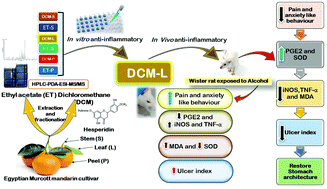Phytochemical characterization and anti-inflammatory potential of Egyptian Murcott mandarin cultivar waste (stem, leaves and peel)†
Abstract
The stem (S), leaf (L) and fruit peel (P) of Murcott mandarins were separately extracted using 80% ethanol and then fractionated into dichloromethane (DCM) and ethyl acetate (ET). Their metabolic profiles were studied via HPLC-PDA-ESI-MS/MS and afforded a tentative characterization of 98 compounds, including free organic acids, phenolic acid derivatives, flavonoid aglycones, flavonoid glycosides, flavonoids containing 3-hydroxyl-3-methylglutaroyl (HMG) units, coumarin derivatives and limonoids. Column chromatography resulted in isolation of six metabolites for the first time that were identified as nobiletin (C1), isosinensetin (C2), limonin (C3), 4′-demethylnobiletin (C4), stigmasterol-O-glucoside (C5) and hesperidin (C6). In vitro studies of the anti-inflammatory activity of DCM-L against cyclooxygenases (COXs) and 5-lipoxygenase (5-LOX) enzymes revealed that DCM-L showed higher activity than the other tested fractions. The in vivo gastroprotective effects of that fraction were evaluated using alcohol-induced gastric ulcers in rats. The obtained findings validated the gastroprotective and anti-ulcerogenic activities of DCM-L through its anxiolytic, anti-inflammatory, antioxidant and anti-apoptotic effects. Therefore, we recommend the use of Murcott mandarin leaves as a part of a protection strategy for gastric ulcer.



 Please wait while we load your content...
Please wait while we load your content...